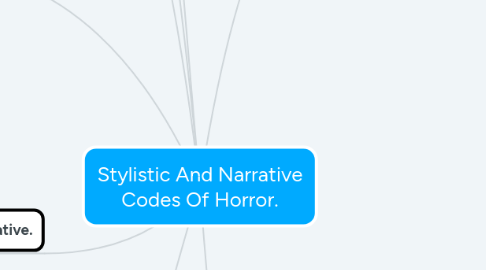
1. Editing
1.1. Quick jump cuts of action which build up tension in a scene.
1.2. Video slowed at tense parts which represents the characters movement.
1.3. zooming in and out which shows the audience a characters facial expression or a wide shot of what they are seeing.
1.4. Video sped up to represent the heart beat of the character.
2. Mise-En-Scene.
2.1. Props.
2.1.1. Kitchen knifes, baseball bats, hammers, pokers, etc. These props are used as weapons because horror movies are typically set in a house so these props are items you would find in a house.
2.1.2. Religious symbols such as crosses and bibles. Creates a sense of hope to the audience as they protect the characters and audiences form demons and satanic forms.
2.2. Iconography.
2.2.1. Hauntings.
2.2.2. Demons and exorcisms.
2.2.3. Gore and blood.
2.2.4. Religious belief.
2.2.5. Satanism.
2.3. Make-up.
2.3.1. Special effects. Special effect
2.3.2. Scars and cuts. The scars and cuts represent the journey of the characters throughout the film.
2.3.3. Blood and gore.
2.4. Costume.
2.4.1. Masks. Masks are a motif to some horror villains which are represented that villain.
2.4.2. Victim/hero: normal bright everyday clothes e.g jeans and a t-shirt at the start but then at the end ripped, dirty bloody clothes which represent that they have been through something e.g fighting a villain.
2.4.3. Villain: dark, ripped, mouldy, old clothes represents that the villain is old or unnatural through its clothing.
2.5. Set.
2.5.1. Urban and rural.
2.5.2. mainly rural e.g woods because rural locations are normally not near civilisation which adds to the horror film because the audience knows that the no one can hear them.
2.6. Location.
2.6.1. Atics. Atics connect with the audience because most houses have atics so the use of them makes the audience scared to be in there own home.
2.6.2. Basements. Basements are used because they are the same as atics where some houses have them. Also basements are underground which has representation of a coffin.
2.6.3. Old houses e.g Victorian houses. They use old houses because that’s have history so a narrative can be built for that history.
2.6.4. Dense woods and forests. They use dense woods because it creates a sense of no escape to the audience which then creates tension and dread.
2.6.5. Abandoned buildings. Abandoned buildings are used to create a creepy and dread as there is no hope that the characters are safe.
2.6.6. Churches. Churches are used as they go with the narrative of religion. Churches also create a sense of hope as the narrative is typically about a demon which needs exorcising which would normally happen in a church.
